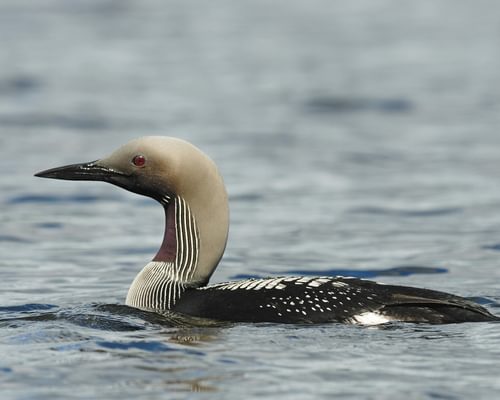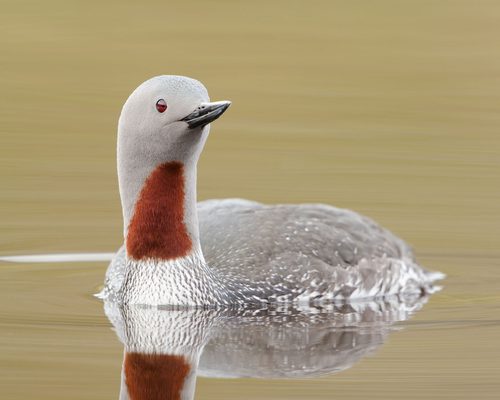Common Loon
Least ConcernGavia immer
Visual Identification
Appearance
The Common Loon is a large waterbird with a distinctive breeding plumage of black and white. Its head and neck are black with a greenish sheen, contrasting sharply with its white-checkered back and white underparts. The bird has a thick, dagger-like bill and red eyes.
In winter, adults moult into a more muted grey plumage with a white throat and underparts. Their bill also fades from black in the summer to pale grey in the winter.
Both sexes are similar in appearance, with females generally smaller. Juveniles resemble winter adults but with scaly-looking feathers on their backs.
Adult Common Loons are most similar to the Yellow-billed Loon (G. adamsii) in breeding plumage, although that species has a pale (not black) bill. Non-breeding adults also resemble smaller species like the Pacific Loon, Arctic Loon, and Red-throated Loon.
Size
Length
66cm to 91cm
Wingspan
122cm to 152cm
Weight
2.5kg to 6.1kg
Colours
Males and females have similar plumage
Primary Colour
Black White
Secondary Colour
Grey
Beak Colour
Black
Leg Colour
Black
Habitat and Distribution
Habitats
Woodland
Garden
Wetland
Coastal
Urban
Farmland
Grassland
Desert
Tundra
Rainforest
Mountain
Savanna
Distribution
Common Loons breed on clear, freshwater lakes across northern North America, from Alaska to Greenland and south to parts of the northern United States. They prefer lakes with abundant fish populations and islands or secluded shorelines for nesting.
During winter, they migrate to coastal marine environments along North America's Atlantic and Pacific coasts, ranging from Alaska to Mexico and Newfoundland to Florida. Some populations also winter on large inland lakes that remain ice-free.
They are winter visitors to the United Kingdom coastline. Although rare inland, birdwatchers might spot them in shallow coastal areas between October and April, particularly in the southwest of England and along Scotland’s northwest coast.
Elevation Range
Sea level to 500 meters
Climate zones
Temperate, Subarctic
Distribution Map
This map gives you a rough idea of where you might spot a Common Loon. The coloured areas show countries where these birds have been seen.
A few things to keep in mind:
- Birds might not be everywhere in the coloured areas, for example, they may be present around the coast of that country
- Where birds live can change with seasons and available food
- This map is quite simple - it doesn't show exact locations
We're working on making our maps even better! Soon, we hope to show you:
- More detailed maps for bigger countries, including state and region
- How birds move around during different seasons
Distribution by Region
Behaviour and Ecology
Bird Attributes
This feature is in beta. We'd love your feedback to improve it!
Share your thoughtsBird Attributes Explained
Our bird attributes system rates various aspects of a bird's capabilities on a scale of 0-100, based on data from field observations, scientific studies, and expert knowledge.
Attribute Categories:
- Agility: Manoeuvrability, speed, and grace in flight or movement.
- Strength: Physical power, often correlating with size and hunting abilities.
- Adaptability: Ability to thrive in various environments or changing conditions.
- Aggressiveness: Territorial behaviour and assertiveness, particularly during breeding seasons.
- Endurance: Stamina, often seen in migration patterns or foraging behaviours.
Understanding the Ratings:
- 0-20: Very Low
- 21-40: Low
- 41-60: Average
- 61-80: High
- 81-100: Very High
Remember, these attributes are relative to other bird species and don't necessarily indicate superiority.
Hover over the icon next to each attribute for more information.
Tap the icon next to each attribute for more information.
Agility
Reflects the bird's manoeuvrability, speed, and grace in flight or movement.
The Common Loon displays remarkable agility in water, capable of swift underwater manoeuvres to catch fish. Their ability to stay submerged for up to five minutes and dive as deep as 60 metres demonstrates exceptional aquatic agility. However, their awkwardness on land slightly reduces their overall agility rating.
Strength
Indicates the bird's physical power, often correlating with size and hunting abilities.
Common Loons possess considerable strength, evident in their ability to dive deep and pursue prey underwater. Their solid bones, unlike most birds' hollow ones, contribute to their strength and diving prowess. Their large size (up to 91 cm in length and 6.1 kg in weight) also indicates significant strength, particularly in flight during long-distance migrations.
Adaptability
Represents the bird's ability to thrive in various environments or changing conditions.
These birds show good adaptability, thriving in both freshwater and marine environments as they migrate between breeding and wintering grounds. They can adjust their diet to include various fish species and aquatic invertebrates. However, their specific nesting requirements and sensitivity to water pollution somewhat limit their adaptability.
Aggressiveness
Measures the bird's territorial behaviour and assertiveness, particularly during breeding seasons.
Common Loons exhibit moderate aggressiveness, particularly during the breeding season. They engage in territorial behaviours, including vocalizations and displays to defend their nesting sites. Their ability to fend off most predators from their chicks also indicates a degree of aggression. However, they are not known for excessive aggression towards other species outside of breeding contexts.
Endurance
Reflects the bird's stamina, often seen in migration patterns or foraging behaviours.
The Common Loon demonstrates exceptional endurance. Their ability to undertake long-distance migrations between inland breeding grounds and coastal wintering areas showcases remarkable stamina. Additionally, their capacity for extended underwater dives and the energy required for their fishing technique further emphasises their high endurance levels.
Diet
Common Loons are primarily piscivores, feeding on a variety of fish species, including perch, suckers, and minnows. They also consume aquatic invertebrates, amphibians, and occasionally aquatic plants.
Loons hunt by diving and pursuing prey underwater, using their sharp bill to catch and hold slippery fish.
Behaviour
Common Loons are exceptional divers, capable of staying underwater for up to five minutes while hunting fish. They are awkward on land due to the rear placement of their legs, which is an adaptation for swimming.
During the breeding season, loons are known for their elaborate courtship displays and territorial behaviours, including synchronised swimming and haunting vocalisations.
Vocalisation
The Common Loon's vocalisations are among the most distinctive of any North American bird. Their repertoire includes a haunting wail that rises and falls, often described as 'loon-like.'
They also produce a yodelling call used in territorial defence and a tremolo, a wavering call often given in flight or when alarmed.
The spooky but beautiful songs and calls of these birds have been featured in many television shows and films and will be familiar to many who have visited northern forested lakes in the spring and summer.
Nesting & Breeding
Common Loons form monogamous pairs and typically return to the same nesting site yearly. The breeding season begins in late spring, with courtship displays including synchronised swimming and vocalisations.
Nests are built close to the water's edge, often on small islands or hummocks. The nest is a mound of vegetation with a depression in the centre. Females usually lay two olive-brown eggs with dark spots.
Both parents incubate the eggs for about 28-30 days. The chicks are precocial and can swim within hours of hatching, but they often ride on their parents' backs for protection. Fledging occurs after 10-11 weeks.
Lifespan
The Common Loon typically lives for 20 to 30 years, with a maximum recorded lifespan of 30.9 years.
Like all birds, lifespan can be affected by factors including predation, habitat quality, disease, and access to food sources.
Conservation and Status
Global Conservation Status
While currently listed as Least Concern globally, Common Loons face threats from habitat loss, water pollution, and climate change.
Conservation efforts focus on protecting nesting sites, managing water levels, and reducing mercury contamination in their aquatic habitats. In some regions, artificial nesting platforms have been introduced to support breeding populations.
Birdwatching Tips
- Look for Common Loons on large, clear lakes in northern regions during summer.
- Listen for their distinctive wailing and yodelling calls, especially at dusk and dawn.
- In winter, search for them along coastal areas in their more subdued grey plumage.
- Observe their diving behaviour; they often surface far from where they submerged.
- Use a spotting scope for better views, as loons often stay far from shore.
Additional Information
Quick Facts
Other names:
Great Northern Diver
Family:
GaviidaePredators
Did You Know?
- Common Loons have solid bones, unlike most birds with hollow bones, which helps them dive deep underwater.
- They can swallow fish underwater and have been known to dive as deep as 60 meters (200 feet).
- The Common Loon is the provincial bird of Ontario, Canada, featured on the Canadian one-dollar coin, known as the 'loonie.'
- These large, powerful birds will use their sharp bills to protect their young from predators, and one adult was even suspected of killing a Bald Eagle in this way!
Was this bird profile helpful?
Your feedback helps us improve our content
Thanks for your feedback!
Your input helps us improve our content.
Community Experience
Community Ratings
No ratings yet - be the first to rate this bird!
Latest Community Reviews
No reviews yet
Sign in to be the first to review
Community Reviews
Create Your Free Account Welcome Back!
Join our community to rate birds and share your experiences. Creating an account is completely free and only takes a minute. Sign in to your account to rate birds and share your experiences with our community.
Your information is secure and will never be shared.
By creating an account, you agree to our Privacy Policy.
Similar Birds
References
- 2
website: BirdLife International. 2018. Gavia immer. The IUCN Red List of Threatened Species 2018: e.T22697842A132607418.
View source - 3 4
report, 2016: Wetlands International
- 1
website: Longevity Records Of North American Birds. Version 2023.1
View source

